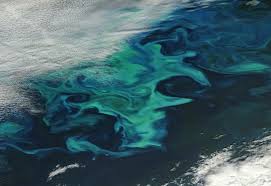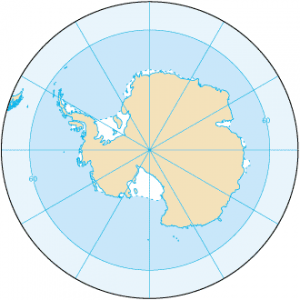Source: Dawson, H. R. S., P. G. Strutton, and P. Gaube (2018), The unusual surface chlorophyll signatures of Southern Ocean eddies. Geophysical Research Letters, doi: 10.1029/2017JC013628
Swirling Currents
The ocean is constantly in motion, and at any given time, the sea is filled with spinning parcels of water called eddies. Ocean eddies range in size from hundreds of meters to hundreds of kilometers across. Larger eddies can travel long distances and in doing so, transport water, heat, and nutrients. They can also be detected by satellites as anomalies in the height of the sea’s surface.
Additionally, the swirling current patterns that characterize eddies are visible in satellite images of ocean color (see Figure 1 below). Why is this the case? In general in the Southern Hemisphere, eddies that rotate clockwise cause cold, nutrient-rich water from the deep ocean to rise up to the surface. These nutrients can support the growth of tiny microalgae called phytoplankton, which appear green in satellite images. In other words, eddies may enhance productivity, and if so, this increased growth should be reflected in satellite ocean color data.

Eddies Enhance Productivity?
A recent study led by Hannah Dawson at the University of Tasmania investigates the connection between large-scale eddies and biological productivity by analyzing satellite data from thousands of eddies recorded between 1997 and 2012. The study uses sea surface height from the NASA satellite altimeter AVISO and ocean color from the SeaWiFS and MODIS satellite missions. In particular, Dawson examined eddies in the ocean surrounding Antarctic, called the Southern Ocean (see map below). Dawson focused on the Southern Ocean because it has a very active eddy field and plays a key role in regulating global climate.

The Southern Ocean takes up nearly 30% of the carbon associated with anthropogenic climate change that is absorbed by the global ocean. Phytoplankton are responsible for some of this transfer of carbon dioxide from the atmosphere to the ocean. They absorb CO2 through photosynthesis, just like trees and other land plants. When the organisms die and sink to the seafloor, the carbon they absorbed gets stored in the deep ocean. Past research suggests that enhanced phytoplankton productivity associated with ocean eddies can act to suck carbon out of the atmosphere. Therefore, better understanding eddy productivity in the Southern Ocean is important for predicting atmospheric carbon dioxide concentrations and global climate.
By analyzing the 15 years of satellite data, Dawson found that the relationship between eddies and biological productivity operates differently depending on the season. As stated previously, we expect that clockwise-rotating eddies will pull nutrient-rich waters up to the surface, consequently increasing phytoplankton growth. The direction of the eddy rotation is important – the way in which the eddy swirling interacts with the rotation of the planet determines whether an eddy pushes water from the surface down into the ocean or if it pulls water up from depth. While Southern Ocean eddies behave how we expect during the winter and spring (clockwise pulling water up to the surface leading to more phytoplankton growth), Dawson found that this relationship does not hold for in the summer and fall. During these seasons, contrary to what is expected, clockwise rotating eddies actually had lower plankton concentrations.
Dawson concludes that since counterclockwise eddies push water down from the surface, they mix the ocean deeper in winter than clockwise eddies. This allows more nutrients from the ocean depths to enter the counterclockwise eddy interiors, eventually leading to higher productivity in summer and fall. The counterintuitive result from this study will impact the way that we view interactions between eddies and biology going forward.
Eddy Impacts
Carbon concentrations in the Southern Ocean are controlled by a complex combination of interaction with the atmosphere, ocean dynamics, and biological processes. Because of this, scientists have different hypotheses about how the Southern Ocean’s ability to absorb carbon will change in the future. By investigating the relationship between eddies and phytoplankton growth in satellite data, this study can help us understand and predict how the ocean’s ability to regulate climate might change in the future.
I’m a physical oceanography PhD student at Scripps Institution of Oceanography in La Jolla, California. I use a combination of numerical models, observations, and remote sensing to investigate the role of the ocean in climate. I’m particularly interested in Southern Ocean dynamics, including air-sea-ice interactions and physical controls on biogeochemistry.

